Wilamowski B.M., Irwin J.D. The Industrial Electronics Handbook. Second Edition: Industrial Communication Systems
Подождите немного. Документ загружается.

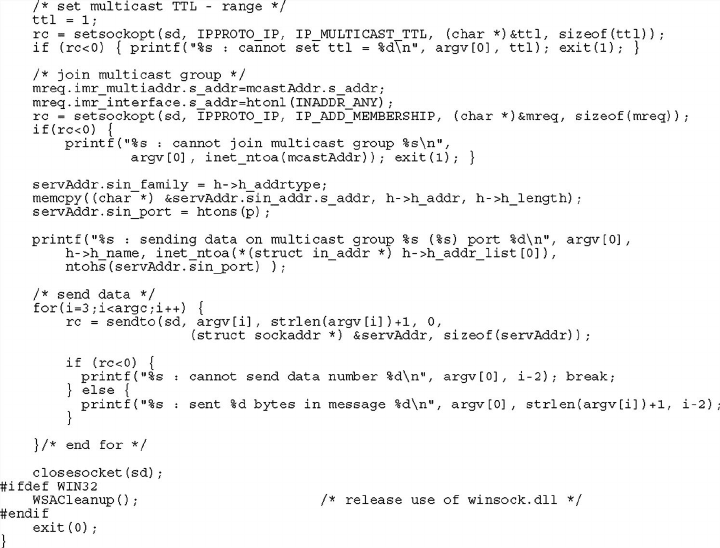
60-10 Industrial Communication Systems
references
[C02–1].D..Comer,.Internetworking with TCP/IP Vol. 1: Principles, Protocols, and Architecture,.5th.edn.,.
Pren
tice
.Ha
ll,
.Up
per
.Saddle.Ri
ver,
.NJ,.2005.
[C02–3]
. D.. Com
er
. et. al.,. Int
ernetworking with TCP/IP,
. Vol
.
. III:. Clien
t-Server Programming and
Applications, Linux/Posix Sockets Version,
.Pr
entice
.Ha
ll,
.Up
per
.Saddle.Ri
ver,
.NJ,.2000.
[F10]
.B.A..Fo
rouzan,
.TCP/IP P
rotocol Suite,
.4th.edn.,.McG
raw-Hill,
.Ne
w
.Yo
rk,
.2010.
[GW03]
.A..Le
on-Garcia,
.I..Wid
jaja,
.Co
mmunication Networks,
.2nd.edn.,.McG
raw-Hill,
.Ne
w
.Yo
rk,
.2003.
[IAN
A]
.We
b
.Si
te
.fo
r
.IAN
A - Internet Assigned Numbers Authority,
.ht
tp://www.iana.org/
[PD07]
.L.L..Peter
son,
.B.S..Dav
ie,
.Com
puter Networks: A System Approach,
.4th.edn.,.Mor
gan
.Kauf
mann
.
Publi
shers,
.San.Fra
ncisco,
.CA,.2007.
[RFC]
.We
b
.Si
te
.fo
r
.RFC Edi
tor,
.ht
tp://www.rfc-editor.org/
[RFC2147]
.D..Bor
man
.et.al.,.TCP.and.UDP.over.IPv6.Jumb
ograms,
.May.1997..htt
p://www.rfc-editor.org/
[RFC2675]
.D..Bo
rman
.et.al
.,
.IPv6.Jum
bograms,
.Augu
st
.1999..ht
tp://www.rfc-editor.org/
[RFC3171]
.Z..Al
bana,
.K..Alm
eroth,
.D..Me
yer,
.M..Sc
hipper,
.IAN
A
.Guide
lines
.fo
r
.IPv4.Mu
lticast
.Addr
ess
.
Assig
nments,
.Augu
st
.2001..ht
tp://www.rfc-editor.org/
[RFC3493]
.R..Gil
ligan
.et.al.,.Basic.Soc
ket
.Int
erface
.Exten
sions
.for.IPv6,.Feb
ruary
.2003..htt
p://www.rfc-
editor.org/
[STD2]
.J..Re
ynolds,
.J..Pos
tel,
.As
signed
.Num
bers,
.Oc
tober
.1994..ht
tp://www.rfc-editor.org/
[STD5]
.J..Pos
tel,
.In
ternet
.Pr
otocol,
.Sep
tember
.1981..ht
tp://www.rfc-editor.org/
[STD6]
.RFC0768/STD0006,.J..Pos
tel,
.Us
er
.Da
tagram
.Pr
otocol,
.Augu
st
.1980..ht
tp://www.rfc-editor.org/
[STD33]
.K..Sol
lins,
.e.Tp.Pro
tocol
.(Rev
ision
.2),.Jul
y
.199
2.
.htt
p://www.rfc-editor.org/
[STD62]
.D..Har
rington,
.R..Pre
suhn,
.B..Wij
nen,
.An.Arc
hitecture
.for.Desc
ribing
.Sim
ple
.Net
work
.Man
agement
.
Pro
tocol
.(SN
MP)
.Man
agement
.Fra
meworks,
.Dec
ember
.200
2.
.htt
p://www.rfc-editor.org/
FIGURE 60.8 (continued)
© 2011 by Taylor and Francis Group, LLC

61-1
61.1 Introduction
Transmission.control.protocol.(TCP).is.a.part.of.TCP/Internet.protocol.(IP).suite.[STD7,C02-1,F10,.
GW03,
PD07].
.It.prov
ides
.full.tran
sport
.laye
r
.serv
ices
.to.appl
ications.
.It.belo
ngs
.to.the.tran
sport
.laye
r
.in.
the.TCP/
IP
.suit
e
.mode
l
.as.show
n
.in.Figu
re
.61.1
.
.TCP.is.more.comp
licated
.than.user.data
gram
.proto
col
.
(UDP
)
.and.prov
ides
.a.reli
able
.conn
ection
.betw
een
.both.ends.of.tran
smission.
.is.conn
ection
.need
s
.
to.be.set.up,.main
tained,
.and.torn.down
.
.e.proto
col
.divi
des
.a.stre
am
.of.data.into.unit
s
.of.limi
ted
.
size.call
ed
.segm
ents.
.ese.segm
ents
.are.reas
sembled
.in.a.reli
able
.way.at.the.othe
r
.end..Reli
ability
.is.
achi
eved
.by.asse
mbling
.segm
ents
.by.pres
erving
.thei
r
.orig
inal
.sequ
ence,
.and.arra
nging
.for.retr
ansmis-
sion
.of.lost.or.corr
upted
.data
.
.Whil
e
.the.unde
rlying
.IP.prov
ides
.logi
cal
.addr
essing
.of.segm
ents
.and.is.
resp
onsible
.for.thei
r
.tran
smission
.thro
ugh
.netw
orks
.[STD
5],
.TCP.prov
ides
.addi
tional
.addr
essing
.that.
allo
ws
.sett
ing
.up.conn
ections
.for.mult
iple
.appl
ications
.and.serv
ices
.on.the.same.end..Each.appl
ication
.
seek
ing
.TCP.conn
ection
.is.assig
ned
.one.or.more.numbe
rs
.(one.numbe
r
.per.conn
ection)
.that.are.call
ed
.
port.numb
ers.
.Fig
ure
.61.
2
.ill
ustrates
.the.con
cept
.of.por
t
.numb
ers.
TCP
.prov
ides
.a.logi
cal
.full.dupl
ex
.conn
ection
.betw
een
.two.appl
ication
.laye
r
.proc
esses.
.e.conn
ec-
tion
.is.perc
eived
.as.a.conn
ection-oriented,
.reli
able,
.in-s
equence
.byte
-stream
.serv
ice.
.e.proto
col
.also.
allo
ws
.the.reci
pient
.of.data.to.cont
rol
.the.rate.at.whic
h
.the.send
er
.tran
smits
.data.to.avoi
d
.bue
r
.over
ow.
•
. Conn
ection-oriented
.show
s
.that.the.conn
ection
.need
s
.to.be.esta
blished
.and.its.para
meters
.nego
ti-
ated
.betw
een
.the.two.proc
esses.
.is.nego
tiation
.is.perf
ormed
.by.send
ing
.tran
smission
.cont
rol
.
bloc
ks
.(TCB
).
.At.the.end.of.the.tran
smission,
.the.conn
ection
.must.be.torn.down
.
.TCP.term
inates
.
each.dire
ction
.of.the.conn
ection
.sepa
rately,
.whic
h
.allo
ws
.the.data.ow.to.cont
inue
.even.aer.the.
othe
r
.dir
ection
.has.bee
n
.clo
sed.
•
. Reli
able
.indi
cates
.that.eith
er
.all.data.are.deli
vered
.or.the.conn
ection
.is.brok
en.
.TCP.is.desig
ned
.
to.work.over.the.IP.and.thus.it.does.not.assu
me
.that.the.unde
rlying
.netw
ork
.serv
ices
.are.reli
able.
.
To.ensu
re
.reli
ability,
.each.chun
k
.of.data.are.numbe
red,
.and.a.sele
ctive
.autom
atic
.repe
at
.requ
est
.
(ARQ
)
.is.emp
loyed
.to.req
uest
.ret
ransmission
.of.los
t
.or.cor
rupt
.dat
a
.chu
nk.
61
Transmission Control
Protocol—TCP
61.1. Introduction..................................................................................... 61-1
61.2
. Proto
col
.Ope
ration.......................................................................... 61-3
TCP.Segment. •. Port.Number.Assignments. •. Connection.
Establishment. •. Maintaining.the.Open.Connection. •. Flow.Control.
and.Sliding.Window.Protocol. •. Improving.Flow.Control. •. Error.
Control. •. Congestion.Control. •. Connection.Termination
61.3. State.Diagram..................................................................................61-14
61.4
. Prog
ramming
.Sam
ples..................................................................61-14
References................................................................................................... 61-17
Aleksander
Malinowski
Bradley University
Bogdan M.
Wilamowski
Auburn University
© 2011 by Taylor and Francis Group, LLC
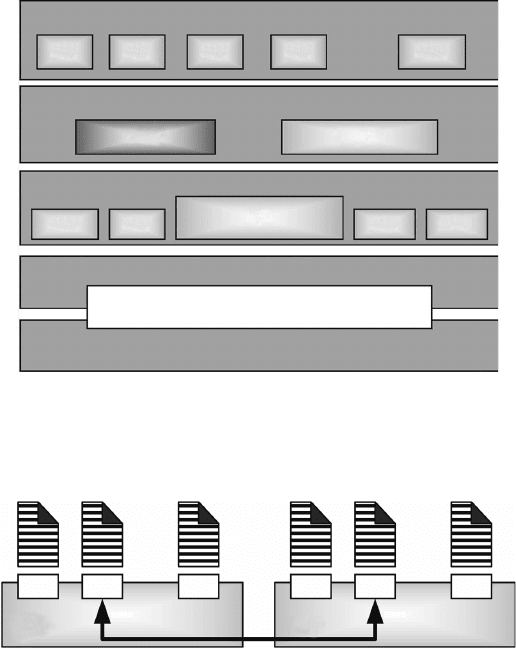
61-2 Industrial Communication Systems
•. In-sequence.shows.that.all.data.are.guaranteed.to.be.received.by.the.end.receiving.process.in.the.
same.order.that.they.were.sent..Sequencing.is.implemented.by.the.same.mechanism.that.is.used.
for.missing.data.chunk.detection..All.received.data.are.placed.in.a.receiving.buer.in.location.
corresponding.to.the.data.chunk.number..e.process.that.receives.data.reads.it.from.that.buer.
in.a.correct.sequence.
•
. Byte-stream.oriented.implies.that.the.connection.can.be.perceived.as.continuous.stream.of.data.
regardless.of.the.fact.that.the.underlying.network.services.may.transmit.data.in.chunks..ose.
data.chunks.may.be.of.various.sizes.and.may.have.maximum.size.limit..e.sending.process,.
however,.may.send.data.either.continuously.or.in.bursts..All.data.to.be.sent.are.placed.in.the.send-
ing
.buer..Data.from.the.buer.are.partitioned.into.chunks,.which.are.called.segments.according.
to.algorithms.of.TCP,.and.then.they.are.sent.over.the.network..On.the.receiving.side,.the.data.
are.placed.in.the.receiving.buer.in.an.appropriate.sequence.as.mentioned.earlier..e.receiving.
process.may.read.data.either.as.chunks.or.as.byte.aer.byte.
•
. Full duplex.indicates.that.each.party.involved.in.the.transmission.has.control.over.it..For.example,.
any.side.can.send.data.at.any.time.or.terminate.the.connection.
The
.TCP.is.standardized.by.Internet Society,.which.is.an.independent.international.nonprofit.
organization.. A. complete. information. about. TCP-related. standards.is. published.by.RFC Editor.
[RFC]..Several.relevant.RFC.articles.as.well.as.further.reading.materials.are.listed.at.the.end.of.this.
article.
Application layer
SMTP FTP
TCP
IGMP ICMP
IP
Physical layer
Data link layer
Network layer
Transport layer
Underlying LAN or WAN technology
ARP RARP
UDP
DNS SNMP BOOTP
FIGURE 61.1 UDP.and.TCP/IP.in.the.TCP/IP.protocol.suite.model.
TCPTCP
Telnet
(client)
Telnet
(server)
23
63158
FIGURE 61.2 Process.to.process.communication.
© 2011 by Taylor and Francis Group, LLC
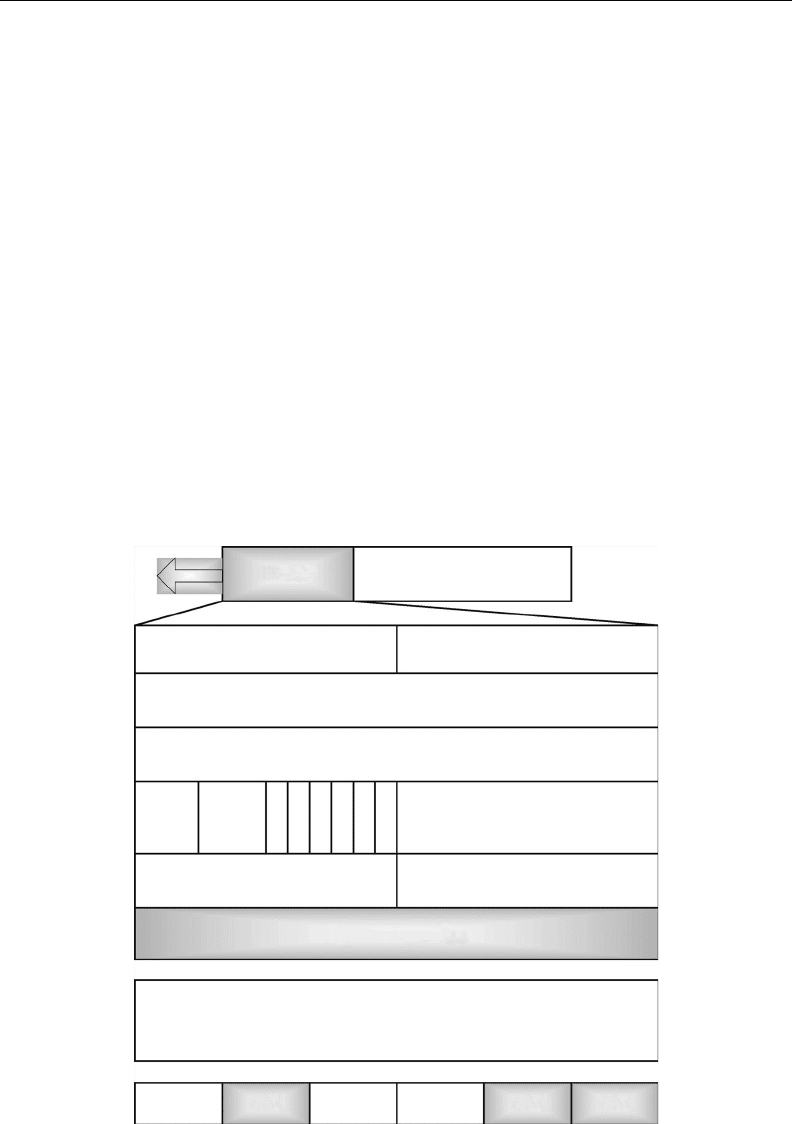
Transmission Control Protocol—TCP 61-3
61.2 Protocol Operation
Before.data.transfer.begins,.TCP.establishes.a.connection.between.two.application.processes.by.setting.
up.the.protocol.parameters..ese.parameters.are.stored.in.a.structure.variable.called.TCB..Once.the.
connection.is.established,.the.data.transfer.may.begin..During.the.transfer,.parameters.may.be.modi-
ed
.to.improve.eciency.of.transmission.and.prevent.congestion..In.the.end,.the.connection.is.closed..
Under.certain.circumstances,.connection.may.be.terminated.without.formal.closing.
61.2.1 tCP Segment
Although.TCP.is.byte-stream.oriented,.connection.and.buering.take.care.of.the.disparities.among.
the.speed.of.preparing.data,.sending.data,.and.consuming.of.data.at.the.other.end,.one.more.step.is.
necessary.before.data.are.sent..e.underneath.IP.layer.that.takes.care.of.sending.data.through.the.
entire.network.sends.data.in.packets,.not.as.a.stream.of.bytes..Sending.one.byte.in.a.packet.would.be.
very.inecient.due.to.the.large.overhead.caused.by.headers..erefore,.data.are.grouped.into.larger.
chunks.called.segments..Each.segment.is.encapsulated.in.an.IP.datagram.and.then.transmitted..Each.
TCP.segment.follows.the.same.format.that.is.shown.in.Figure.61.3.[STD7]..Each.segment.consists.of.a.
header.that.is.followed.by.options.and.data..e.meaning.of.each.header.eld.will.be.discussed.now,.and.
its.importance.is.illustrated.in.the.following.sections,.which.show.phases.of.a.typical.TCP.connection.
•
. Source port address:.is.is.a.16.bit.eld.that.contains.a.port.number.of.the.process.that.sends.
options.or.data.in.this.segment.
•
. Destination port address:.is.is.a.16.bit.eld.that.contains.a.port.number.of.the.process.that.is.
supposed.to.receive.options.or.data.carried.by.this.segment.
Destination port number
16 bits
Source port number
16 bits
Sequence number
32 bits
Acknowledgment number
32 bits
Window size
16 bits
Urgent pointer
16 bits
Checksum
16 bits
HLEN
4 bits
Reser-
ved
6 bits
Header Data
u a p
r
r s
sc s y i
f
g k h t n
n
Options and padding
URG: Urgent pointer is vaild
ACK: Acknowledgment is valid
PSH: Request for push
RST: Reset the connection
SYN: Synchronize sequence number
FIN: Terminate the connection
URG ACK PSH RST SYN FIN
FIGURE 61.3 TCP.segment.format.
© 2011 by Taylor and Francis Group, LLC

61-4 Industrial Communication Systems
•. Sequence number:.is.is.a.32.bit.eld.that.contains.the.number.assigned.to.the.rst.byte.of.
data.carried.by.this.segment..During.the.establishment.of.connection.each.side.generates.its.
own.random.initial.sequence.number.(ISN)..e.sequence.number.is.then.increased.by.one.with.
every.1.byte.of.data.sent..For.example,.if.a.previous.segment.had.a.sequence.number.700.and.had.
200bytes.of.data.then.sequence.number.of.the.next.segment.is.900.
•
. Acknowledgment number:.is.is.a.32.bit.eld.that.contains.the.sequence.number.for.the.next.seg-
ment
.that.is.expected.to.be.received.from.the.other.party..For.example,.if.the.last.received.segment.
had.a.sequence.number.700.and.had.200.bytes.of.data,.then.the.acknowledgment.number.is.900.
•
. Header length:.is.4.bit.eld.contains.the.total.size.of.the.segment.header.divided.by.4..Since.
headers.may.be.20–60.bytes.long,.the.value.is.in.the.range.5–15.
•
. Reserved:.is.6.bit.eld.is.reserved.for.future.use.
•
. Control:.is.6.bit.eld.contains.transmission.control.ags.
•
. URG:.Urgent..If.the.bit.is.set,.then.the.urgent.pointer.is.valid.
•
. ACK:.Acknowledgment..If.the.bit.is.set.then.the.acknowledgment.number.is.valid.
•
. PSH:.Push..If.the.bit.is.set,.then.the.other.party.should.not.buer.the.outgoing.data.but.send.it.
immediately,.as.it.becomes.available,.without.buering.
•
. RST:.Reset..If.the.bit.is.set,.then.the.connection.should.be.aborted.immediately.due.to.abnormal.
condition.
•
. SYN:.Synchronize..e.bit.is.set.in.the.connection.request.segment.when.the.connection.is.being.
established.
•
. FIN:.Finalize..If.the.bit.is.set,.it.means.that.the.sender.does.not.have.anything.more.to.send,.and.
that.the.connection.may.be.closed..e.process.will.still.accept.data.from.the.other.party.until.the.
other.party.also.sends.FIN.
•
. Window size:.is.16.bit.eld.contains.information.about.the.size.of.the.transmission.window.that.
the.other.party.must.maintain..Window.size.will.be.explained.and.illustrated.later.
•
. Checksum:.is.16.bit.eld.contains.the.checksum..e.checksum.is.calculated.by
•
. Initially.lling.it.with.0s
•
. Adding.a.pseudoheader.with.information.from.IP,.as.illustrated.in.Figure.61.4.
•
. Treating.the.whole.segment.with.the.pseudoheader.prepended.as.a.stream.of.16.bit.
numbers..If.the.number.of.bytes.is.odd,.0.is.appended.at.the.end.
Pseudoheader
Header
32 bit source IP address
All 0s 8 bit protocol (6)
Source port Destination port
Sequence number
Acknowledgment number
HLEN
Reserved
Control
Window size
Urgent pointer
Checksum
Options (optional) and data
(padding must be added to make the
data a multiple of 16 bits)
16 bit TCP total length
32 bit destination IP address
FIGURE 61.4 Pseudoheader.added.to.the.TCP.datagram.
© 2011 by Taylor and Francis Group, LLC
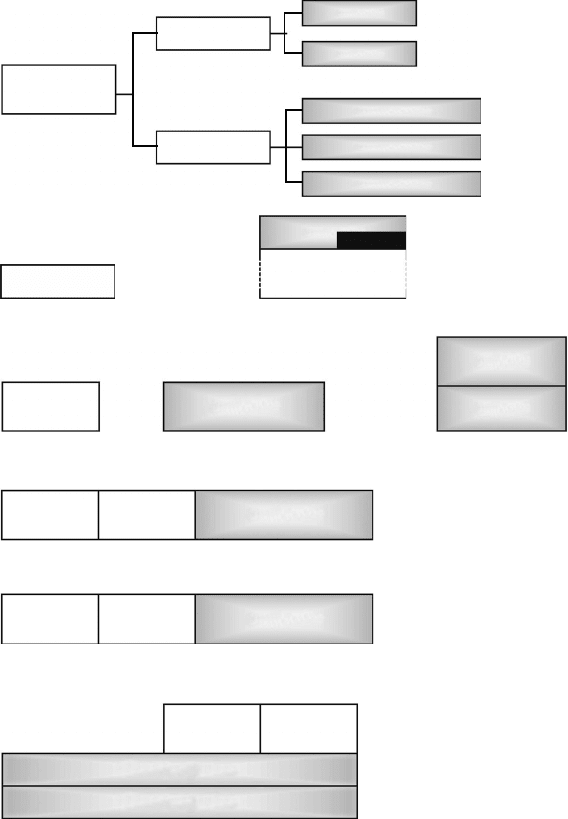
Transmission Control Protocol—TCP 61-5
•. Adding.all.16.bit.numbers.using.1s.complement.binary.arithmetic.
•
. Complementing.the.result..is.complemented.result.is.inserted.into.the.checksum.eld.
•
. Checksum verication:.e.receiver.calculates.the.new.checksum.for.the.received.packet,.which.
includes.the.original.checksum,.aer.adding.the.pseudoheader.(see.Figure.61.4)..If.the.new.check-
sum
.is.nonzero.then.the.packet.is.corrupt.and.is.discarded.
•
. Urgent pointer:.is.16.bit.eld.is.used.only.if.the.URG.ag.is.set..It.denes.the.location.of.the.last.
urgent.byte.in.the.data.section.of.the.segment..Urgent.data.are.those.that.are.sent.out-of-sequence..
For.example,.telnet.client.sends.a.break.character.without.queuing.it.in.the.sending.buer.
•
. Options:.ere.can.be.up.to.40.bytes.of.options.appended.to.the.header..e.options.are.padded.
inside.with.0s.so.that.the.total.number.of.bytes.in.the.header.is.divisible.by.4..e.possible.options.
are.listed.below.and.are.illustrated.in.Figure.61.5:
(4)
Code:2
00000010
Length:4
00000100
1 byte 1 byte 2 bytes
Maximum segment size
(3)
Code:1
00000001
a. End of option b. Used to align beginning of an option c. Used to align the next option
A 7-byte option
An 8-byte option
All 11-byte option
(5)
Length:3
00000011
Code:3
00000011
Scale factor
1 byte 1 byte 1 bytes
(6)
Length:10
00001010
Code:8
00001000
Timestamp value
Timestamp echo reply
(1)
Options
Single-byte
End of option
No operation
Maximum segment size
Window scale factor
Timestamp
Multiple-byte
(2)
Options
Data
a. End of option b. Used for padding
END-OP
Code:0
00000000
FIGURE 61.5 TCP.options:.1..classication;.2..end.of.options;.3..no.operation.(used.for.padding);.4..setting.
maximum.segment.size;.5..setting.window.scale.factor;.6..time.stamp.
© 2011 by Taylor and Francis Group, LLC
61-6 Industrial Communication Systems
•. No operation:.1.byte.option.used.as.ller.between.the.options.and.as.padding.
•
. End
of options:
.1.byt
e
.opti
on
.use
d
.as.pad
ding
.at.the.end.of.opti
ons
.le
d.
.Dat
a
.por
tion
.of.
the.se
gment
.fo
llows
.im
mediately.
•
. Max
imum segment size (MSS):
.Opt
ion
.de
nes
.the.max
imum
.siz
e
.of.a.chu
nk
.of.dat
a
.
tha
t
.can.be.rec
eived.
.It.ref
ers
.to.the.siz
e
.of.dat
a
.not.the.who
le
.seg
ment.
.It.is.use
d
.onl
y
.
dur
ing
.the.est
ablishment
.of.the.con
nection.
.e.rec
eiving
.par
ty
.de
nes
.the.max
imum
.
siz
e
.of.the
datagram
.sen
t
.by.the.sen
der.
.If.not.spe
cied,
.the.def
ault
.max
imum
.is.536
.
.
Bec
ause
.the.len
gth
.of.the.dat
agram
.is.not.spe
cied
.in.the.TCP.hea
der,
.the
re
.is.no.len
gth
.
lim
itation
.for.an.ind
ividual
.TCP.pac
ket.
.How
ever,
.the.MSS.val
ue
.tha
t
.is.neg
otiated
.at.
the.beg
inning
.of.the.con
nection
.lim
its
.the.lar
gest
.TCP.pac
ket
.tha
t
.can.be.sen
t,
.and.the.
Urg
ent
.Poi
nter
.can
not
.ref
erence
.dat
a
.bey
ond
.65,
535
.byt
es.
.MSS.val
ue
.of.65,
535
.is.tre
ated
.
as.in
nity
.[RF
C2675]
.[RF
C2147].
•
. Win
dow scale factor:
.For.hig
h
.thr
oughput
.cha
nnels
.the.win
dow
.size.fro
m
.the.seg
ment
.
hea
der
.(16.bit
,
.max
imum
.65,
535)
.may.not.be.su
cient.
.is.3.byt
e
.opti
on
.de
nes
.the.
mul
tiplication
.fac
tor
.for.the.win
dow
.size
.
.e.act
ual
.win
dow
.size.is.com
puted
.usin
g
.the.
fol
lowing
.fo
rmula
.
Actual window size Window size
window scale factor
= ⋅2
.
•. Tim
e stamp:
.is.is.a.10.byt
e
.opt
ion
.tha
t
.hol
ds
.the.tim
e
.sta
mp
.val
ue
.of.tra
nsmitted
.seg
-
ment.
.Whe
n
.an.ack
nowledgment
.is.sen
t,
.the.sam
e
.val
ue
.is.use
d.
.is.all
ows
.the.ori
gi-
nal
.sen
der
.to.det
ermine
.the.opt
imal
.ret
ransmission
.tim
e
.bas
ed
.on.the.pac
ket
.rou
nd
.
tri
p
.tim
e.
61.2.2 Port Number assignments
In.order.to.provide.a.platform.for.an.independent.process.addressing.on.a.host,.each.connection.of.the.
pro
cess
.to.the.net
work
.is.assi
gned
.a.16.bit.numb
er.
.er
e
.are.thr
ee
.cat
egories
.of.por
t
.numb
ers:
.wel
l-
known
.(0–
1,023),
.reg
istered
.(1,
024–49,151),
.and.eph
emeral
.(49
,152–6,553).
.Wel
l-known ports
.hav
e
.bee
n
.
his
torically
.assi
gned
.to.com
mon
.ser
vices.
.Som
e
.ope
rating
.sys
tems
.req
uire
.tha
t
.the.pro
cess
.tha
t
.uti
-
lizes
.tho
se
.por
ts
.mus
t
.hav
e
.adm
inistrative
.pri
vileges.
.is.req
uirement
.was.his
torically
.cre
ated
.to.avo
id
.
hac
kers
.run
ning
.ser
ver
.imp
osters
.on.mul
tiuser
.sys
tems.
.Wel
l-known
.por
ts
.are.reg
istered
.and.con
-
trolled
.by.Int
ernet
.Assi
gned
.Numb
ers
.Aut
hority
.(IA
NA)
.[IA
NA,STD2].
.Tab
le
.61.
1
.sho
ws
.wel
l-known
.
por
ts
.com
monly
.use
d
.by.TCP
.
.Reg
istered ports
.are.als
o
.reg
istered
.by.IAN
A
.to.avo
id
.pos
sible
.con
icts
.
amo
ng
.di
erent
.app
lications
.att
empting
.to.use.the.sam
e
.por
t
.for.lis
tening
.to.inc
oming
.con
nections.
.
Eph
emeral
.por
ts
.are.als
o
.cal
led
.dyn
amic
.por
ts.
.es
e
.por
ts
.are.use
d
.by.out
going
.con
nections
.tha
t
.are.
typ
ically
.assi
gned
.to.the.rs
t
.ava
ilable
.por
t
.abo
ve
.49,
151.
.Man
y
.ope
rating
.sys
tems
.may.not.fol
low
.IAN
A
.
rec
ommendations
.and.tre
at
.the.reg
istered
.por
ts
.ran
ge
.as.eph
emeral.
.For.exa
mple,
.BSD.use
s
.por
ts
.1,0
24
.
thr
ough
.4,9
99
.as.eph
emeral
.por
ts,
.man
y
.Lin
ux
.ker
nels
.use.32,7
68–61,000,
.Wind
ows
.use.1,0
25–5,000,
.
whi
le
.Fr
eeBSD
.fo
llows
.IA
NA
.po
rt
.ra
nge.
For
.exa
mple,
.a.Web.Ser
ver
.usu
ally
.use
s
.wel
l-known
.por
t
.80,.a.pro
xyserver
.may.typ
ically
.use.reg
is-
tered
.por
t
.8,0
00,
.8,0
08,
.or.8,0
80,
.a.Web.bro
wser
.use
s
.mul
tiple
.eph
emeral
.por
ts,
.one.for.eac
h
.new.con
-
nection
.op
en
.to.do
wnload
.a.co
mponent
.of.a.We
b
.pa
ge.
.Ep
hemeral
.po
rts
.ar
e
.ev
entually
.re
cycled.
61.2.3 Connection Establishment
Before.data.transfer.begins,.TCP.establishes.a.connection.between.two.application.processes.by.set-
ting
.up.the.pro
tocol
.par
ameters.
.es
e
.par
ameters
.are.sto
red
.in.a.str
ucture
.var
iable
.cal
led
.TCB
.
.
© 2011 by Taylor and Francis Group, LLC
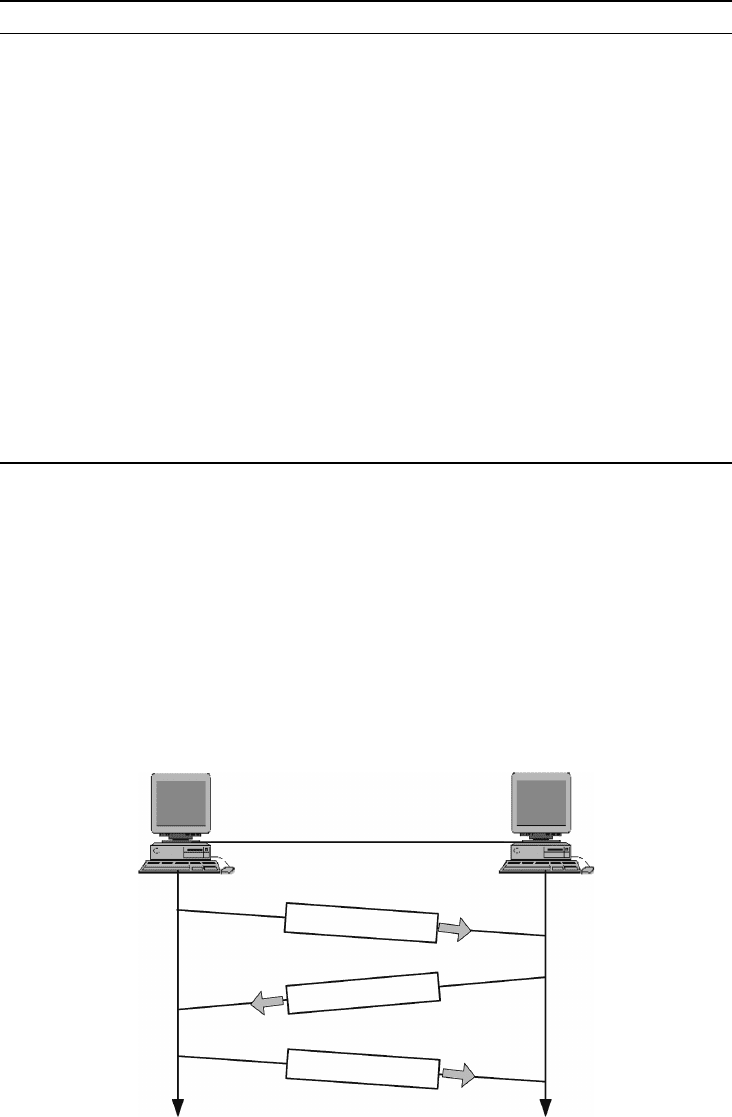
Transmission Control Protocol—TCP 61-7
Before.the.two.parties—called.here.as.host.A.and.host.B—can.start.sending.data,.four.actions.must.
be.performed:
. 1..Host.A.sends.a.segment.announcing.that.it.wants.to.establish.connection..is.segment.includes.
initial.information.about.trac.from.A.to.B.
. 2.. Host.B.sends.a.segment.acknowledging.the.request.received.from.A.
. 3..Host.B.sends.a.segment.with.information.about.trac.from.B.to.A.
. 4.. Host.A.sends.a.segment.acknowledging.the.request.received.from.B.
e
.second.and.the.third.steps.can.be.combined.into.one.segment..erefore,.the.connection.estab-
lishment
.described.is.also.called.three-way.handshaking..Figure.61.6.illustrates.an.example.of.segment.
Sender Receiver
Segment 1: SYN
Segment 2: SYN+ACK
Segment 3: ACK
seq:11,200, ack:---
seq:14,800, ack:11,201
seq:11,201, ack:14,801
Time Time
FIGURE 61.6 ree-way.handshaking.during.connection.establishment.
TABLE 61.1 Common.Well-Known.Ports.Used.with.TCP
Port Protocol Description RFC/STD.#
7 Echo Echoes
.a.received.data.back.to.its.sender STD20
9 Discard Discards
.any.data.that.are.received STD21
13 Daytime Returns
.the.date.and.the.time.in.ASCII.string.format STD25
19 Chargen Sends
.back.arbitrary.characters.until.connection.closed STD22
20 FTP
.Data File.Transfer.Protocol.(data.transmission.connection,.unencrypted) STD9
21 FTP
.Control File.Transfer.protocol.(control.connection,.unencrypted) STD9
22 SSH Secure
.Shell.(SSH)—used.for.secure.logins,.le.transfers.(scp,.sp),.
and.port.forwarding
RFC4250-4256
23 Telnet Telnet
.(unencrypted) STD8,.STD27-32
25 SMTP Simple
.Mail.Transfer.Protocol.(sending.email) STD10
37 Time Returns
.the.current.time.in.seconds.since.1/1/1900.in.a.32.bit.format STD26
53 Nameserver Domain
.Name.Service STD13
80 HTTP Hypertext
.Transfer.Protocol RFC2616
110 POP3 Post
.Oce.Protocol.3.(email.download) STD53
111 RPC SUN
.Remote.Procedure.Call RFC5531
143 IMAP Interim
.Mail.Access.Protocol.v2.(email.access) RFC2060
443 SHTTP Secure
.Hypertext.Transfer.Protocol RFC2660
995 POP3 POP3
.over.TLS/SSL RFC2595
© 2011 by Taylor and Francis Group, LLC
61-8 Industrial Communication Systems
exchange.during.connection.establishment..Among.the.two.programs.that.are.involved.in.the.connection,.
the.ser
ver
.pro
gram
.is.the.one.tha
t
.pas
sively
.wai
ts
.for.ano
ther
.par
ty
.to.con
nect.
.It.wil
l
.be.cal
led
.sho
rtly
.
as.the.ser
ver.
.It.tel
ls
.the.und
erlying
.TCP.lib
rary
.in.its.sys
tem
.tha
t
.it.is.rea
dy
.to.acc
ept
.a.con
nection.
.e.
pro
gram
.tha
t
.act
ively
.see
ks
.con
nection
.is.cal
led
.a.cli
ent
.pro
gram.
.It.wil
l
.be.cal
led
.sho
rtly
.as.the.cli
ent.
.
e.cli
ent
.tel
ls
.the.und
erlying
.lib
rary
.in.its.sys
tem
.tha
t
.it.nee
ds
.to.con
nect
.to.a.par
ticular
.ser
ver
.tha
t
.is.
de
ned
.by.th
e
.co
mputer
.IP.ad
dress
.an
d
.th
e
.de
stination
.po
rt
.nu
mber.
. 1.. e.cli
ent
.sen
ds
.the.rs
t
.seg
ment
.tha
t
.inc
ludes
.the.sou
rce
.and.des
tination
.por
t
.wit
h
.SYN.bit.set
.
.e.
seg
ment
.als
o
.con
tains
.the.ini
tial
.val
ue
.of.Seq
uence
.Num
ber,
.whic
h
.is.als
o
.cal
led
.ISN.tha
t
.wil
l
.be.use
d
.
by.the.cli
ent
.in.this.conn
ection.
.e.cli
ent
.may.als
o
.sen
d
.som
e
.opt
ions
.as.nec
essary,
.for.exa
mple,
.to.
alter.the.window.size,.or.maximum.segment.size.in.order.to.change.their.values.from.default.
. 2.. e.serv
er
.send
s
.the.secon
d
.segm
ent
.tha
t
.has.bot
h
.ACK.and.SYN.bit.sets
.
.is.is.don
e
.in.ord
er
.to.
bot
h
.ack
nowledge
.rece
iving
.the.rs
t
.segm
ent
.fro
m
.the.cli
ent
.(AC
K)
.and.to.ini
tialize
.the.sequ
ence
.
num
ber
.in.the.dir
ection
.fro
m
.the.serv
er
.to.the.cli
ent
.(SY
N).
.e.Ack
nowledgment
.num
ber
.is.set.to.
the.cli
ent’s
.ISN.+.1..e.serv
er
.ISN.is.set.to.a.ran
dom
.num
ber.
.e.opt
ion
.to.de
ne
.cli
ent
.win
dow
.
siz
e
.mus
t
.also.be.sent
.
. 3.. In.rep
ly
.to.the.seg
ment
.fro
m
.the.ser
ver,
.the.cli
ent
.sen
ds
.as.seg
ment
.wit
h
.ACK.bit.set.and.the.
seg
ment
.num
ber
.set.to.its.ISN.+.1..e.Ack
nowledgment
.num
ber
.is.set.to.the.ser
ver
.ISN.+.1.
. 4.. In.ver
y
.rar
e
.situ
ation,
.the.two.pro
cesses
.may.wan
t
.to.sta
rt
.con
nection
.at.the.sam
e
.tim
e.
.In.tha
t
.
cas
e,
.bot
h
.wil
l
.iss
ue
.an.act
ive
.ope
n
.seg
ment
.wit
h
.SYN.and.ISN
,
.and.the
n
.bot
h
.wou
ld
.sen
d
.the.
ACK.seg
ment.
.A.situ
ation
.whe
n
.one.of.the.seg
ments
.is.los
t
.dur
ing
.the.tra
nsmission
.and.nee
ds
.to.
be.re
sent
.a
er
.ti
me-out
.ma
y
.al
so
.be.an
alyzed.
61.2.4 Maintaining the Open Connection
Aer.connection.is.established,.each.process.can.send.data..Each.segment.has.its.sequence.number.
inc
reased
.by.the.numb
er
.of.byt
es
.sen
t
.in.the.pre
vious
.seg
ment,
.wit
h
.the.pre
vious
.seq
uence
.numb
er.
.e.
numb
er
.rol
ls
.ove
r
.at.2
32
..e.process.expects.to.receive.segments.with.ACK.bit.set.and.acknowledgment.
numb
ers
.tha
t
.con
rm
.tha
t
.dat
a
.are.rec
eived.
.Ack
nowledgment
.numb
er
.is.not.mer
ely
.the.rep
etition
.
of.the.rec
eived
.seq
uence
.numb
er.
.It.ind
icates
.the.nex
t
.exp
ected
.seq
uence
.numb
er
.of.a.seg
ment
.to.be.
rec
eived
.by.the.ack
nowledging
.pro
cess.
.Ack
nowledgments
.mus
t
.be.rec
eived
.wit
hin
.cer
tain
.tim
e
.fra
me,
.
not.eve
ry
.seg
ment
.tha
t
.is.sen
d
.nee
ds
.to.be.ack
nowledged.
.Sen
ding
.ack
nowledgment
.of.a.cer
tain
.seg
-
ment
.als
o
.ack
nowledges
.rec
eiving
.all.pre
vious
.seg
ments.
.Mor
e
.seg
ments
.are.usu
ally
.sen
t
.ahe
ad
.bef
ore
.
the.sen
der
.exp
ects
.to.rec
eive
.an.ack
nowledgment.
.Sen
ding
.an.ack
nowledgment
.can.be.comb
ined
.wit
h
.
sen
ding
.da
ta
.in.th
e
.ot
her
.di
rection
.(p
iggybacking).
61.2.5 Flow Control and Sliding Window Protocol
e.amount.of.data.may.be.sent.before.waiting.for.an.acknowledgment.from.the.destination..In.extreme.
situ
ations,
.the.pro
cess
.may.wai
t
.for.an.ack
nowledgment
.for.eac
h
.seg
ment
.but.tha
t
.wou
ld
.mak
e
.the.lon
g
.
dis
tance
.tra
nsmission
.ver
y
.slo
w
.due.to.lon
g
.lat
ency.
.On.the.oth
er
.han
d,
.the.pro
cess
.may.sen
d
.all.dat
a
.
wit
hout
.wai
ting
.for.con
rmation.
.is.is.als
o
.imp
ractical
.bec
ause
.hig
h
.vol
ume
.of.dat
a
.may.nee
d
.to.be.
ret
ransmitted
.in.ca
se
.a.se
gment
.is.lo
st
.in.th
e
.mi
ddle
.of.th
e
.tr
ansmission.
Sliding
.win
dow
.pro
tocol
.is.a.sol
ution
.in-b
etween
.the.two.ext
reme
.situ
ations
.des
cribed
.abo
ve
.tha
t
.
TCP.imp
lements
.in.ord
er
.to.spe
ed
.up.the.tra
nsmission.
.TCP.sen
ds
.as.muc
h
.dat
a
.as.all
owed
.by.a.so-
c
alled
.sli
ding
.win
dow
.bef
ore
.wai
ting
.for.an.ack
nowledgment.
.Ae
r
.rec
eiving
.an.ack
nowledgment,
.it.
mov
es
.(s
lides)
.th
e
.wi
ndow
.ah
ead
.in.th
e
.ou
tgoing
.da
ta
.bu
er,
.as.il
lustrated
.in.Fi
gure
.61
.7.
On
.the.rec
eiving
.side
,
.inc
oming
.dat
a
.are.stor
ed
.in.the.rec
eiving
.bu
er
.bef
ore
.dat
a
.are.con
sumed
.
by.the.com
municating
.pro
cess.
.Sin
ce
.the.size.of.the.bu
er
.is.lim
ited,
.the.numb
er
.of.byt
es
.tha
t
.can.be.
rec
eived
.at.a.par
ticular
.tim
e
.is.lim
ited.
.e.size.of.the.unu
sed
.por
tion
.of.the.bu
er
.is.cal
led
.the.rec
eiver
window.
.In.ord
er
.to.mai
ntain
.the.ow.con
trol,
.the.sen
der
.mus
t
.be.pre
vented
.fro
m
.sen
ding
.the.exc
essive
.
© 2011 by Taylor and Francis Group, LLC

Transmission Control Protocol—TCP 61-9
amount.of.data.and.overowing.the.incoming.data.buer..is.is.implemented.by.controlling.the.
timing.when.the.acknowledgments.are.sent.
If
.the.receiving.process.consumes.data.at.a.faster.rate.than.they.arrive,.then.the.receiver.window.
expands..is.information.is.passed.to.the.sender.as.an.option.included.in.a.segment.so.that.the.
sender.may.synchronize.the.size.if.its.sender window..is.allows.more.data.to.be.sent.without.receiv-
ing
.an.acknowledgment..If.the.receiving.process.consumes.data.slower.than.they.arrive,.then.the.
receiver.buer.shrinks..In.that.case,.the.receiver.must.inform.the.sender.to.shrink.the.sender.window.
as.well..is.causes.transmission.to.wait.for.more.frequent.acknowledgments.and.prevents.data.from.
being.sent.without.possibility.of.storing..If.the.receiving.buer.is.full,.then.the.receiver.may.close.
(set.to.zero).the.receiver.window..e.sender.cannot.send.any.more.data.until.the.receiver.reopens.
the.window.
61.2.6 Improving Flow Control
In.case.when.one.or.both.communicating.processes.process.the.data.slowly,.then.a.problem.leading.to.
signicant.bandwidth.waste.may.arise..In.case.of.slow.transmission.caused.by.the.receiving.processes,.
the.sliding.window.may.be.reduced.even.as.low.as.to.1.byte..In.case.of.slow.transmission.caused.by.the.
sender,.data.may.be.sent.as.soon.as.it.is.produced.even.with.a.large.window,.one.byte.at.a.time,.as.well..
is.causes.use.of.segments.that.carry.small.data.payload,.and.lowers.the.ration.of.carried.data.size.to.
the.total.segment.size,.and.to.the.total.packet.size.in.the.underlying.protocols..Extensive.overview.of.these.
and.other.problems.that.may.develop.is.provided.by.[RFC2525].and.[RFC2757]..Due.to.size.limitation.
of.this.article.only.two.most.commonly.known.problems.are.discussed.and.their.classic.solutions.are.
provided.here.
To
.prevent.this.situation,.data.should.not.be.sent.immediately.as.and.when.it.becomes.available,.but.
combined.in.larger.chunks,.provided.that.this.approach.is.suitable.for.a.particular.application..Nagle.
found.a.very.good.and.simple.solution.for.the.sender,.which.is.called.Nagle’s Algorithm.[RFC896]..e.
algorithm.can.be.described.by.the.following.three.steps:
•
. e.rst.piece.of.data.are.sent.immediately.even.if.it.is.only.1.byte.
•
. Aer.sending.the.rst.segment,.the.sender.waits.for.the.acknowledgment.segment.or.until.enough.
data.are.accumulated.to.ll.in.the.segment.of.the.maximum.segment.size,.whichever.happens.
rst..en,.it.sends.the.next.segment.with.data.
•
. e.previous.step.is.repeated.until.the.end.of.transmission.
On
.the. receiving. side,. two. dierent.solutions.are.frequently. used.. Clark. proposed. to. send. the.
acknowledgment.as.soon.as.the.incoming.segment.arrives,.but.to.set.the.window.to.zero.if.the.receiv-
ing
.buer.is.full.(Figure.61.8b).[RFC813]..en,.to.increase.the.buer.only.aer.a.maximum.size.
of.a.segment.can.be.received.or.half.of.the.buer.becomes.empty..e.other.solution.is.to.delay.the.
acknowledgment.and.thus.prevent.the.sender.from.sending.more.segments.with.data..e.latter.of.
the.two.solutions.creates.less.network.trac.but.it.may.cause.unnecessary.retransmission.of.segment,.
if.the.delay.is.too.long.
Sliding window
1 2 3 4 5
Pointer
Bytes
can be sent
Bytes
cannot be sent
Bytes
have been sent
Acknowledged
bytes
6 7 8 9 10 11 12 13 14 15 16
FIGURE 61.7 Sender.buer.and.sliding.window.protocol.
© 2011 by Taylor and Francis Group, LLC
